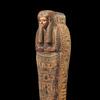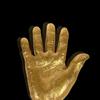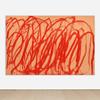The Amon Carter Museum of American Art to Unveil New Thomas Moran Acquisition in Exhibition Telling the Little-Known Story of the Artist’s Westward Journey by Rail
- FORT WORTH, Texas
- /
- June 23, 2021
Moran’s Mount Superior will be on view to the American public for the first time in over 100 years
This summer, the Amon Carter Museum of American Art (the Carter) will unveil the acquisition of a rare watercolor, Mount Superior, as viewed from Alta, Little Cottonwood Canyon, Utah (ca. 1879) by Thomas Moran in an exhibition that will explore the origin of the work—a little-known story of the artist’s westward journey along the transcontinental railroad—within the context of both the history and the art of the period, as well as the artist’s renowned career. The new acquisition will be exhibited alongside a variety of Moran’s work including an oil painting and prints from the museum’s collection as well as contemporaneous photographs, watercolors, and ephemera, illuminating the life and cultural backdrop of one of America’s most important landscape painters. Thomas Moran’s Mount Superior will be on view at the Carter from August 28 through December 12, 2021.
Unlike Moran’s better-known works tied to early geological surveys, Mount Superior documents the artist’s encounter with western space by way of the recently completed Union Pacific and Central Pacific rail lines. Inspired by the sights of a summer trip with his younger brother and fellow artist, Peter Moran, the watercolor connects Moran to an important moment of transition in perceptions of the West as industry and access were rapidly expanding.
Mount Superior’s precise brushwork and treatment of the natural world embodies the principles of the Pre-Raphaelite style as espoused by leading Victorian art critic John Ruskin. Emblematic of Moran’s significance within the movement, he was one of the only American artists known to have been represented in Ruskin’s personal collection. Mount Superior—previously owned by Ruskin—is a rare, high-quality Moran watercolor that has not been publicly exhibited in the U.S. for more than a century. Following Ruskin’s death in 1900, Mount Superior entered a private British collection, disappearing from records of the artist’s work until 2018 when it resurfaced on the market. The introduction of Mount Superior into the Carter’s works on paper collection adds depth to the museum’s extensive representation of Moran’s landscape imagery. It also serves as a key touchstone within the museum’s American Pre-Raphaelite holdings, which include some of the country’s most technically precise landscapes produced in the 19th century.
“The acquisition of Moran’s Mount Superior perfectly complements the Carter’s collection of the artist’s etchings and watercolors and exemplifies our commitment to preserving American masterworks and the stories they tell,” said Andrew J. Walker, Executive Director. “Celebrating this new acquisition in a dedicated exhibition demonstrates our unique ability to share these stories, drawing from both our extensive Moran holdings and the museum’s unparalleled archives and 19th-century photography holdings to provide meaningful context for the artist’s formative impact on American visual culture.”
Drawing upon the Carter’s deep holdings of work by Moran and his family, as well as other ephemera and visual objects from the era, Thomas Moran’s Mount Superior explores Moran’s broader artistic practice and its relationship to popular conceptions of the West in the late 1870s and early 1880s. While Moran is most often associated with themes of western discovery, this exhibition uses historical photography of railway construction and other documentary materials, including tourist postcards and a novelty stereograph, to craft a sense of place around the creation of Mount Superior and connect Moran’s journey and resulting watercolor to the urban development that was taking place throughout the West at the time. The exhibition also includes several of Peter Moran’s watercolors from the trip, etchings by Thomas and his wife, Mary Moran, and photographs of Panama by Thomas’ older brother John Moran, whose travels, like those of his brothers, aligned with major industrial projects.
“In recounting the circumstances of Moran’s trip, we have a platform to highlight the Carter’s holdings of vernacular imagery, a particular strength of our photography collection,” said Kristen Gaylord, Assistant Curator of Photographs. “Through both their visual depictions and their original intended use, these supporting materials capture the world surrounding Mount Superior, offering fresh perspective on Moran’s cultural significance.”
“Displaying this long-lost watercolor for the first time, the Carter has a unique opportunity to shed new light on an iconic American artist as he forged his place within the rapidly industrializing West,” added Spencer Wigmore, Assistant Curator of Painting, Sculpture, and Works on Paper.
Illustrating the narrative power of the museum’s exceptional archival, photography and works on paper collections, Thomas Moran’s Mount Superior helps celebrate the Carter’s 60th year of collecting, preserving, and exhibiting the finest examples of American art.



_Infinity_by_Santiago_Medina_PhotoCr100x100_c.jpg)












